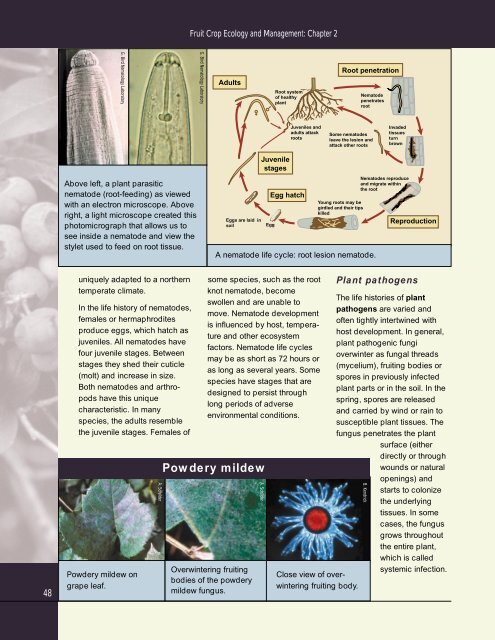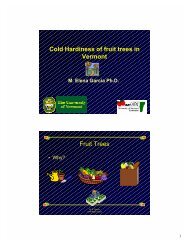Fruit Crop Ecology and Management - UVM Apple Orchard
Fruit Crop Ecology and Management - UVM Apple Orchard
Fruit Crop Ecology and Management - UVM Apple Orchard
You also want an ePaper? Increase the reach of your titles
YUMPU automatically turns print PDFs into web optimized ePapers that Google loves.
48<br />
G. Bird Nematology Laboratory<br />
Above left, a plant parasitic<br />
nematode (root-feeding) as viewed<br />
with an electron microscope. Above<br />
right, a light microscope created this<br />
photomicrograph that allows us to<br />
see inside a nematode <strong>and</strong> view the<br />
stylet used to feed on root tissue.<br />
uniquely adapted to a northern<br />
temperate climate.<br />
In the life history of nematodes,<br />
females or hermaphrodites<br />
produce eggs, which hatch as<br />
juveniles. All nematodes have<br />
four juvenile stages. Between<br />
stages they shed their cuticle<br />
(molt) <strong>and</strong> increase in size.<br />
Both nematodes <strong>and</strong> arthropods<br />
have this unique<br />
characteristic. In many<br />
species, the adults resemble<br />
the juvenile stages. Females of<br />
Powdery mildew on<br />
grape leaf.<br />
A. Schilder<br />
<strong>Fruit</strong> <strong>Crop</strong> <strong>Ecology</strong> <strong>and</strong> <strong>Management</strong>: Chapter 2<br />
G. Bird Nematology Laboratory<br />
Adults<br />
Eggs are laid in<br />
soil<br />
Root system<br />
of healthy<br />
plant<br />
Juvenile<br />
stages<br />
Egg hatch<br />
Juveniles <strong>and</strong><br />
adults attack<br />
roots<br />
some species, such as the root<br />
knot nematode, become<br />
swollen <strong>and</strong> are unable to<br />
move. Nematode development<br />
is influenced by host, temperature<br />
<strong>and</strong> other ecosystem<br />
factors. Nematode life cycles<br />
may be as short as 72 hours or<br />
as long as several years. Some<br />
species have stages that are<br />
designed to persist through<br />
long periods of adverse<br />
environmental conditions.<br />
Powdery mildew<br />
Overwintering fruiting<br />
bodies of the powdery<br />
mildew fungus.<br />
Egg<br />
Close view of overwintering<br />
fruiting body.<br />
Root penetration<br />
Some nematodes<br />
leave the lesion <strong>and</strong><br />
attack other roots<br />
Young roots may be<br />
girdled <strong>and</strong> their tips<br />
killed<br />
Nematode<br />
penetrates<br />
root<br />
A nematode life cycle: root lesion nematode.<br />
A. Schilder<br />
Invaded<br />
tissues<br />
turn<br />
brown<br />
Nematodes reproduce<br />
<strong>and</strong> migrate within<br />
the root<br />
Reproduction<br />
Plant pathogens<br />
The life histories of plant<br />
pathogens are varied <strong>and</strong><br />
often tightly intertwined with<br />
host development. In general,<br />
plant pathogenic fungi<br />
overwinter as fungal threads<br />
(mycelium), fruiting bodies or<br />
spores in previously infected<br />
plant parts or in the soil. In the<br />
spring, spores are released<br />
<strong>and</strong> carried by wind or rain to<br />
susceptible plant tissues. The<br />
fungus penetrates the plant<br />
surface (either<br />
directly or through<br />
wounds or natural<br />
B. Kendrick<br />
openings) <strong>and</strong><br />
starts to colonize<br />
the underlying<br />
tissues. In some<br />
cases, the fungus<br />
grows throughout<br />
the entire plant,<br />
which is called<br />
systemic infection.



